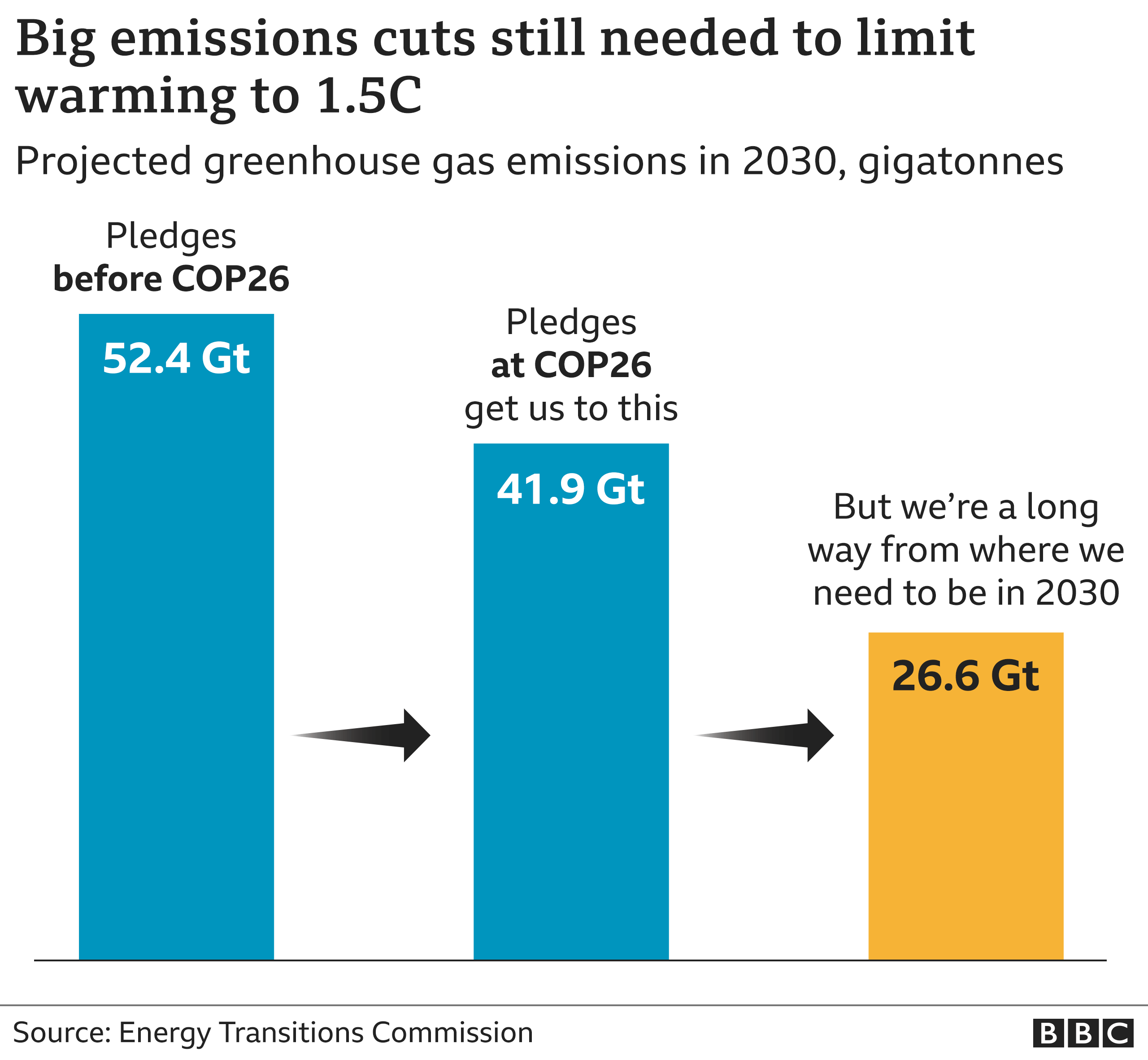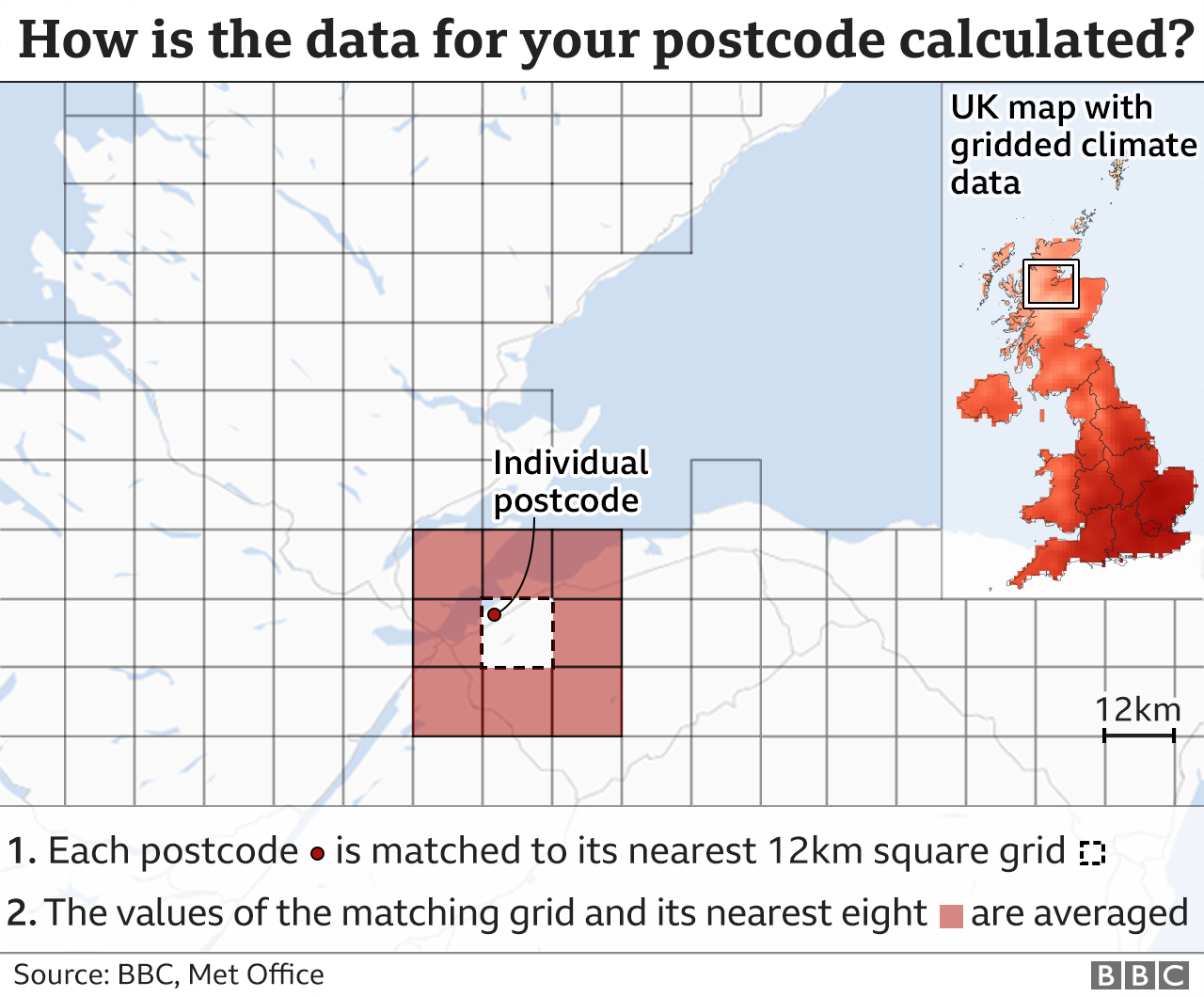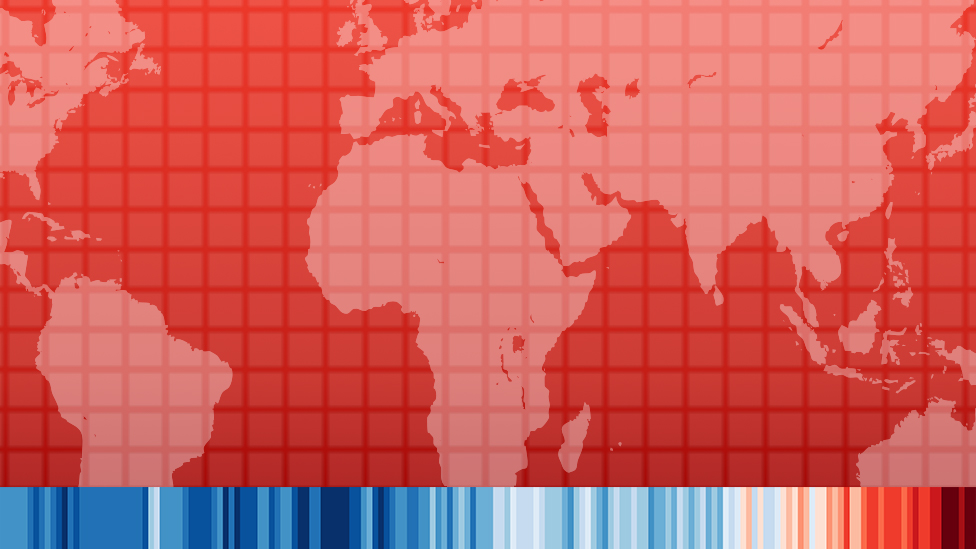
What will climate change look like near me?
How high might temperatures climb and how much rain might fall in your area and how? The �鶹������ҳ��� and the Met Office have looked at the UK's changing climate in detail to find out.
Temperatures in the UK exceeded 40C for the first time on record earlier this summer, and extreme weather events are likely to become even more frequent.
The Met Office climate projections cover different levels of global warming. When, or if, these levels are reached will depend on the concentration of greenhouse gases in our atmosphere.
The data is measured in 12km-square (7.5-mile-square) grids across the UK. The results for your postcode represent an average for the grids closest to you and the mid-point of a range of future possibilities, which come from the Met Office’s most recent major climate modelling data.
How could the climate change near you?
Hottest day
Your local area
The hottest summer day in the 30 years from 1991 to 2019 near you was {{beginHighlight}}{{current_hottest_day}}C{{endHighlight}}. If global average temperatures increase 2C above pre-industrial levels, the hottest summer day could be about {{beginHighlight}}{{medium_hottest_day}}C{{endHighlight}}. If global temperatures rise by 4C, it could be about {{beginHighlight}}{{high_hottest_day}}C{{endHighlight}}.
The warmest winter day in the 30 years from 1991 to 2019 near you was {{beginHighlight}}{{current_hottest_day}}C{{endHighlight}}. If global average temperatures increase 2C above pre-industrial levels, the warmest winter day could be about {{beginHighlight}}{{medium_hottest_day}}C{{endHighlight}}. If global temperatures rise by 4C, it could be about {{beginHighlight}}{{high_hottest_day}}C{{endHighlight}}.
Current
(1991-2019)
2C
global warming
4C
global warming
The UK
The hottest day recorded in the UK came in July 2022, with 40.3C measured in at Coningsby in Lincolnshire.
Human activity has increased carbon dioxide (CO2) emissions and caused rising temperatures worldwide since the growth of industrialisation in the 19th Century.
If global average temperatures rise by 2C above pre-industrial levels, days at least as hot the 2019 record could be more frequent and widespread.
And with a 4C rise, parts of the UK could see temperatures above 42C.
Urgent cuts in emissions are needed to keep the rise in global average temperatures in check.
The Glasgow Climate Pact, reached at the COP26 summit in 2021, agreed countries will meet this year to pledge further cuts to emissions of carbon dioxide (CO2). This is to try to keep temperature rises within 1.5C - which scientists say is required to prevent a "climate catastrophe". Current pledges, if met, will only limit global warming to about 2.4C.
Summer days
Your local area
In the the 30 summers from 1991 to 2019, there were {{beginHighlight}} {{current_summer_days}} days{{endHighlight}} above 25C per month on average. If global temperatures rise by 2C, there could be {{beginHighlight}}{{medium_summer_days}} days{{endHighlight}}. With a 4C rise, there could be {{beginHighlight}}{{high_summer_days}} days{{endHighlight}}.
Current
(1991-2019)
2C
global warming
4C
global warming
The UK
The World Meteorological Organization (WMO) defines any day with a maximum temperature above 25C as a "summer day".
In the 30 summers from 1991 to 2019, even the warmest places in the UK, located in the South, had no more than seven days a month above 25C on average.
If global average temperatures rise by 2C, southern parts of the country could see more than 11 days per summer month go beyond 25C.
If the rise is 4C, those places could have 20 or more summer days per month, and higher likelihood of hot spells triggering public-health warnings.
The cooler, northern parts of the UK, which may not see many days above 25C even with a 4C rise, can nonetheless expect average daytime temperatures in summer to increase by at least 2.5C.
Average daytime summer temperature, UK
4C global warming


The Met Office climate projections for the UK indicate significant temperature rises in the decades ahead for both winter and summer, with the greatest increases in the already warmer South.
Extreme weather could become more frequent and intense.
Not every summer will be hotter than the last – but temperature records are expected to be regularly broken, while heatwaves are likely to be longer and happen more often.
Rainy days
Your local area
In the 30 years from 1991 to 2019, there were {{beginHighlight}} {{current_rainy_days}} rainy days{{endHighlight}} on average per month in summer. If global average temperatures rise by 2C, this could be {{beginHighlight}}{{medium_rainy_days}} days{{endHighlight}} per month. At a 4C rise it could be about {{beginHighlight}}{{high_rainy_days}} days{{endHighlight}}.
In the 30 years from 1991 to 2019, there were {{beginHighlight}}{{current_rainy_days}} rainy days{{endHighlight}} on average per month in winter. At both 2C and 4C rises, the number of rainy days per month could be roughly the same.
Current
(1991-2019)
2C
global warming
4C
global warming
The UK
As the world warms, fewer rainy days in summer are expected.
Currently, over a quarter of the UK has 20 or more days without rain each summer month. This could grow to more than half the country if we reach 4C global warming.
Winter rains could remain as likely as they are now. The number of days will vary from year-to-year, but rainy days in a warmer future could be wetter than today with total rainfall expected to rise.
Wettest day
Your local area
Current
(1991-2019)
2C
global warming
4C
global warming
The UK
In warmer winters the heaviest rains are likely to get more intense. If global average temperatures rise by 4C above pre-industrial levels, half the country could expect at least 20% more rainfall on the wettest winter days.
Summer rains may also become heavier in many places, although total rainfall is expected to decline.
Of course, not all of the heaviest rains will necessarily fall in these two seasons. The current wettest day on record was 3 October 2020, when enough rain fell across all four nations to fill Loch Ness.
Total winter rainfall, UK
4C global warming


The UK climate projections suggest increases in winter rainfall in most parts of the country, as well as drier summers.
Rainfall measurements fluctuate from year to year, making projections challenging.
Not every winter will necessarily be rainier than the one before, and not every summer will be dry, but both trends could have big impacts.
What difference will climate change make?
As the world warms, the UK is likely to have hotter, drier summers and warmer, wetter winters, according to the Met Office.
Extreme weather events such as heatwaves and heavy downpours could become more frequent and more intense. Many scientists are concerned.
"I think it’s really frightening,” says Dr Lizzie Kendon, a senior Met Office scientist. “It's just a wake-up call really as to what we’re talking about here.”
We are already seeing the impacts of climate change, but the level of global warming we reach and by when will depend primarily on the concentration of greenhouse gases in the atmosphere.
To some, warming weather may not seem like such a big deal. But even the smallest incremental changes in climate can have far-reaching effects.
Temperatures above 30C for two or more days can trigger a public-health warning. In the 1990s, this happened about once every four years for locations in the South. By the 2070s, projections suggest it could be as frequently as four times per year - 16 times more often, if we do not curb our emissions.
 Reuters
Reuters
The Met Office projects rainy winters, which keep the soil wet into spring, and dry summers of infrequent rainfall will become the norm.
More floods, less snow?
Summer rain is likely to become less frequent but could be heavier. Without regular rainfall, the ground has a harder time absorbing water when it finally does come, leading to a greater risk of flash flooding.
Floods will likely become a staple of warming winters as well.
Steady rain, which is currently a feature of winter months, will probably continue, and total rainfall is expected to increase.
When the ground is already saturated, waterways tend to rise. Bridges and sewers designed for historical rainfall levels may come increasingly under pressure.
Warming temperatures could also mean cold spells become less frequent.
And snowy UK winters could become thing of the past as climate change affects the UK, according to Met Office analysis shared with �鶹������ҳ��� Panorama.
Temperatures below freezing during the day and areas with considerable amounts of snow on the ground may be limited to parts of Scotland by the end of the century if emissions continue to rise.












 World now sees twice as many days over 50C
World now sees twice as many days over 50C
 How much warmer is your city?
How much warmer is your city?
 What's your diet's carbon footprint?
What's your diet's carbon footprint?